This morning, after we Bloggerhead Kingbirds competed at the Superbowl of Birding all day Saturday (more on that later), we made our way to the Gloucester fishing pier (in Essex County, Massachusetts) and into a gull-conundrum. You see, a couple of other birders, Tim and Brian, had a gull and it wasn’t just any gull. They refused to prejudice us by putting a name to it but it quickly became clear we were looking at a third-cycle dark-mantled gull that could maybe be a Slaty-backed Gull, which, of course, is a heck of a bird in Massachusetts.
I am in no way competent to make that call. I could tell that it seemed weird for a Great Black-backed Gull, but that is about as far as my analysis went. After we saw the bird we birded around for awhile and then we went back to the fishing pier where we found that the bird had not been refound. We searched for awhile with others and did not find it. Over lunch we on the team discussed it and I took these brief notes:
- pink legs
- yellow eye with dark smudging around it, iris was very pale
- head rounded
- bill not as heavy as GBBG
- bill had yellow tip
- black ring around bill like a RBGU‘s
- dark mantle not as dark as GBBG
- mantle was mottled
- slightly smaller than GBBG and larger than HEGU
- band across tail
- white rump
And, of course, digiscoper that I am, I got pictures. These shots are from long range and are not too good. They can be clicked upon for bigger versions. The only modifications made are cropping and resizing.
A Slaty-backed Gull would be absolutely great but it is a rare bird and rare birds are rare. But this bird just resists being put in the Great Black-backed Gull box, at least to me (and to everyone who looked at it in person). Were we suffering from wishful thinking?
I’m sure other folks who were on this bird (and are more competent with gulls) will want to get their two cents in as well.
Thoughts? Opinions? Questions? Please fire away in the comments.

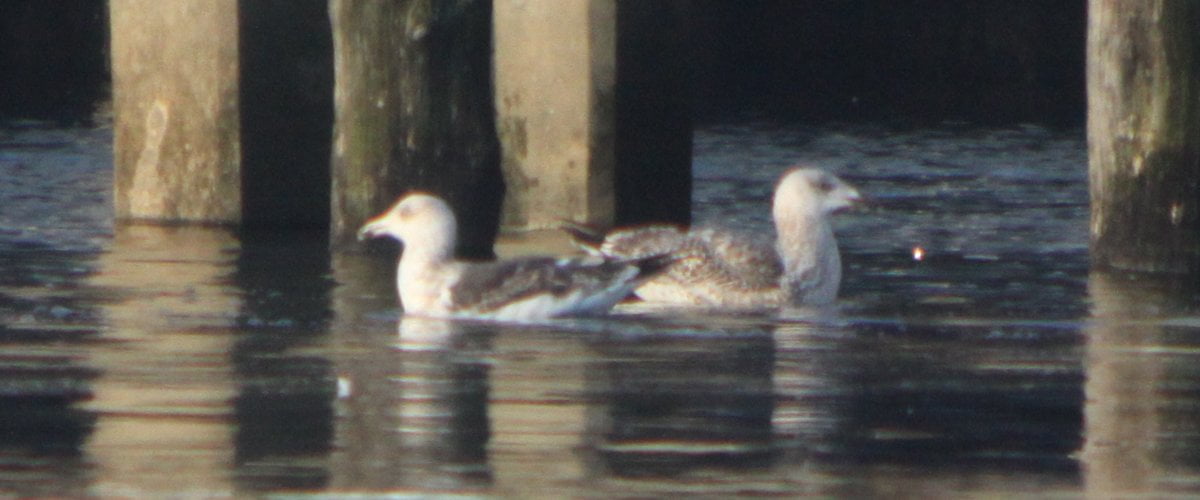
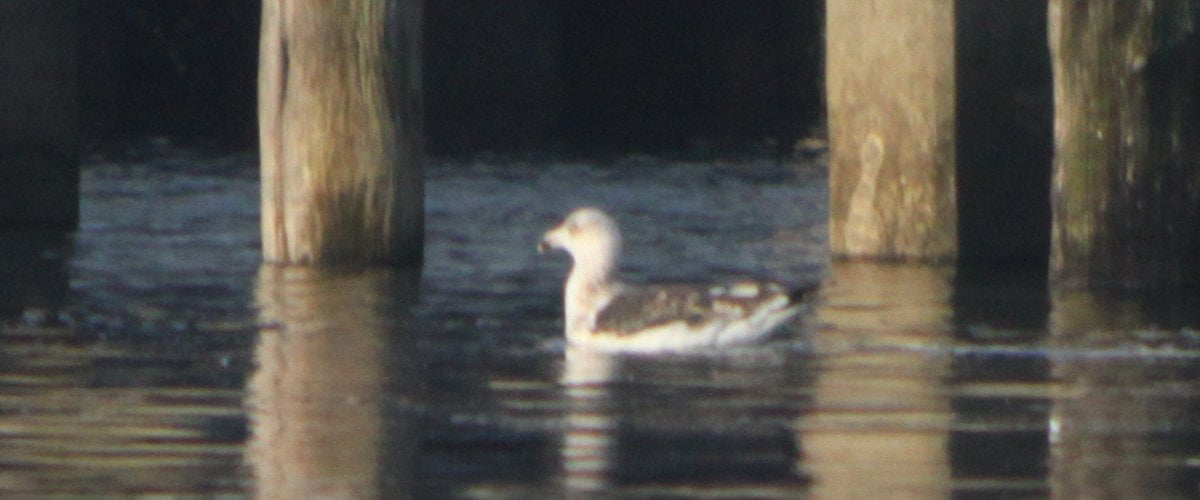
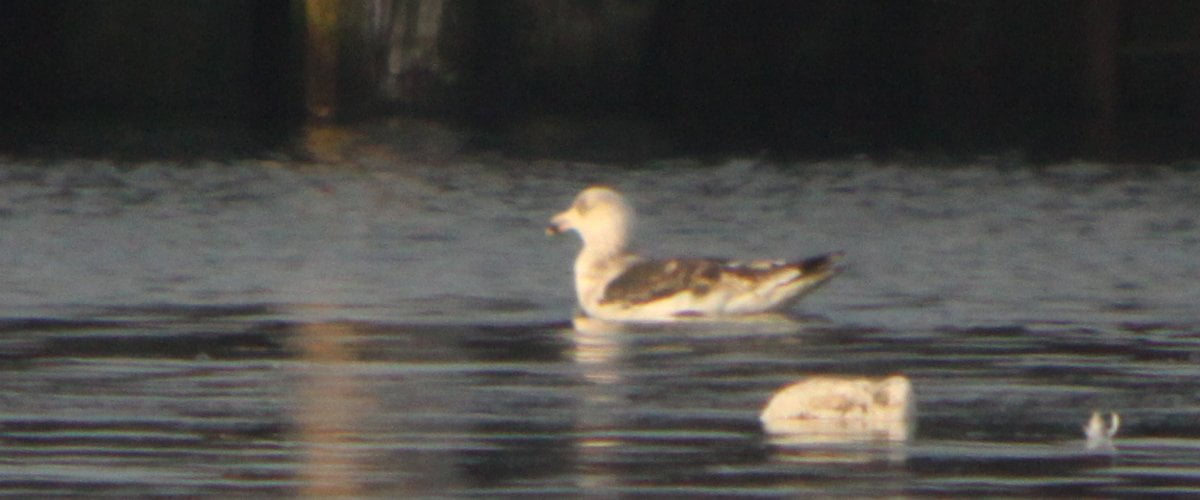
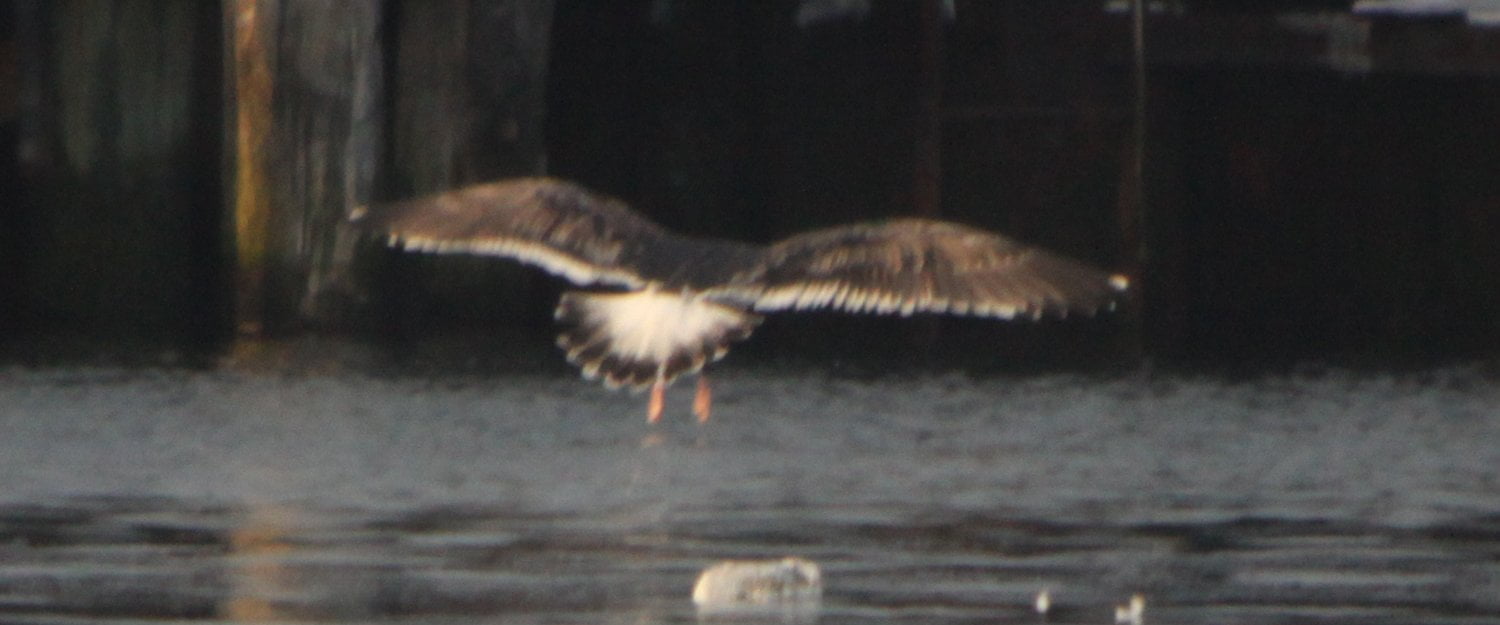
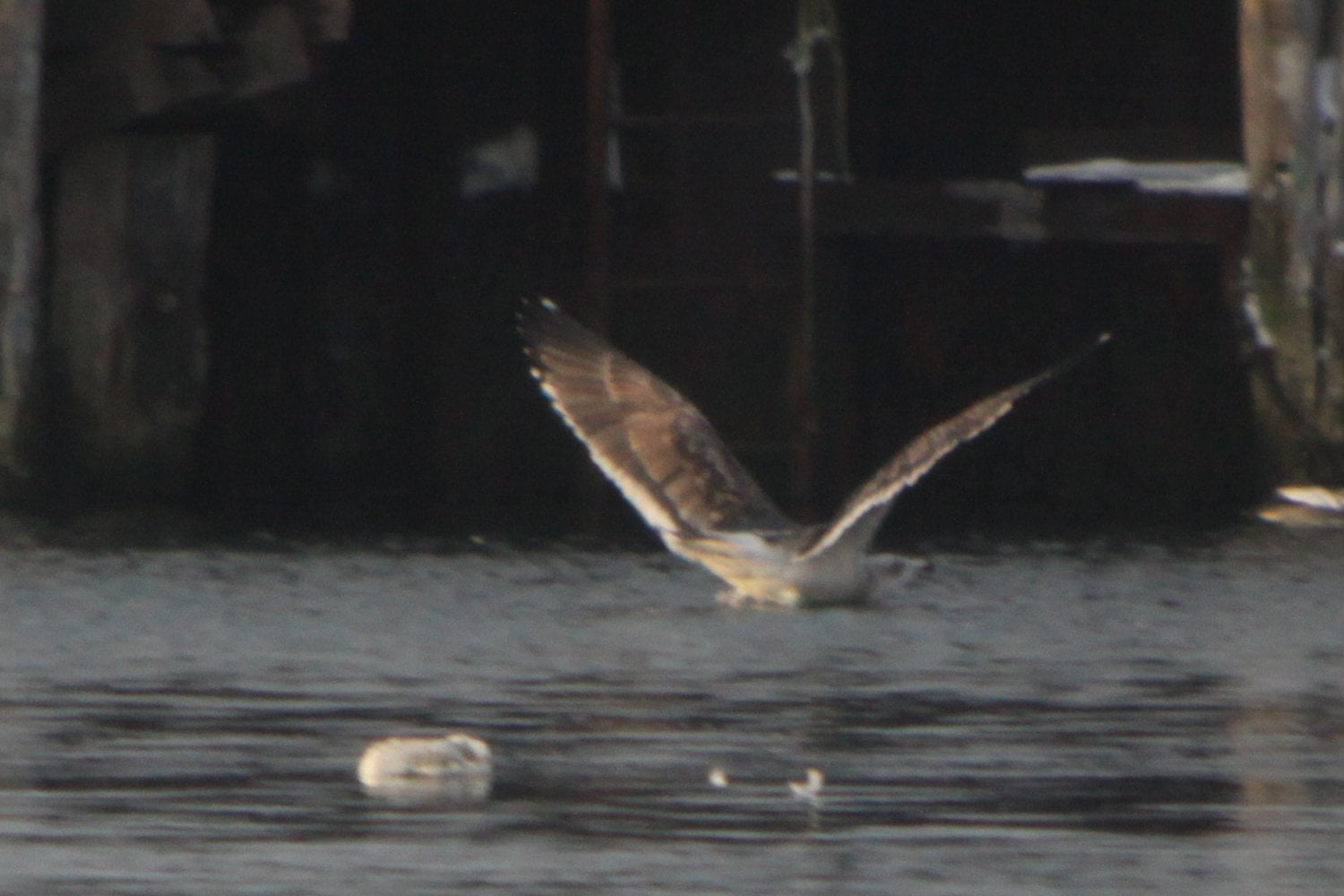
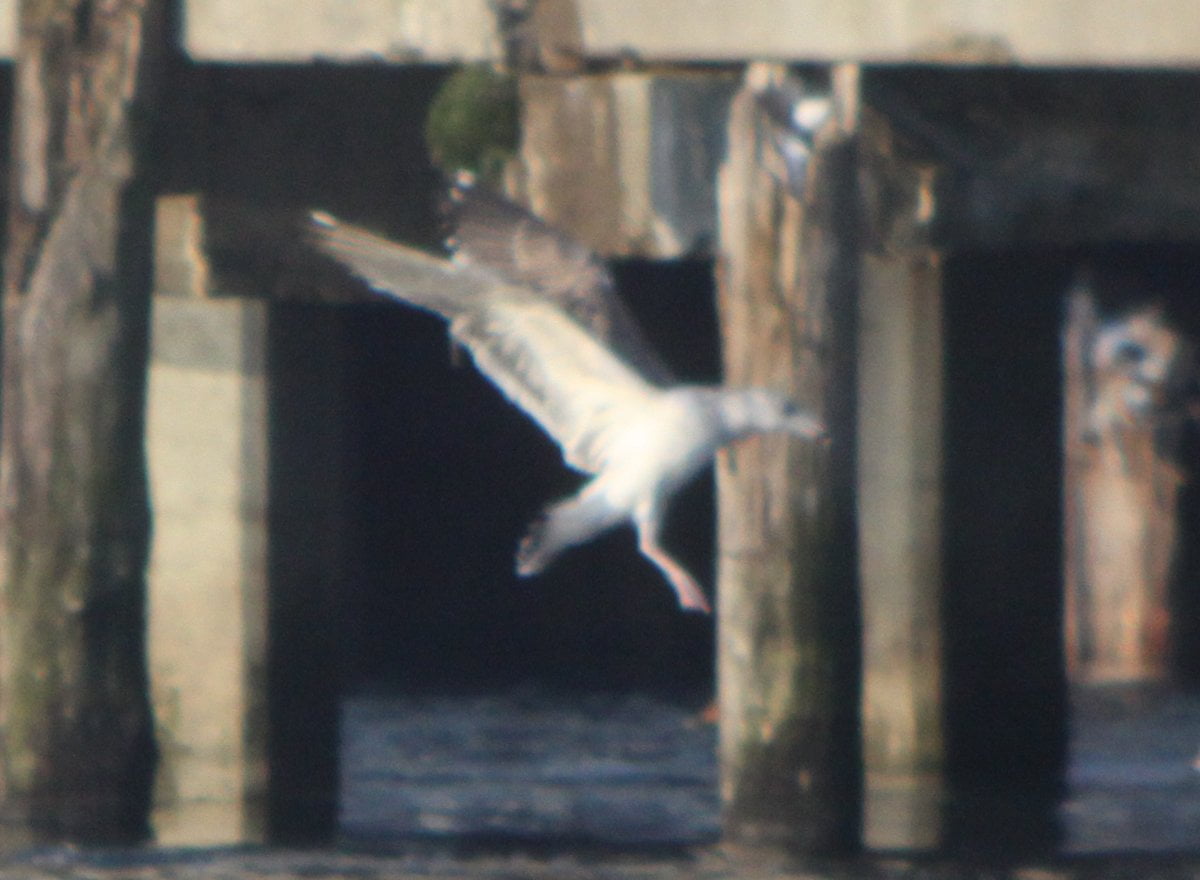
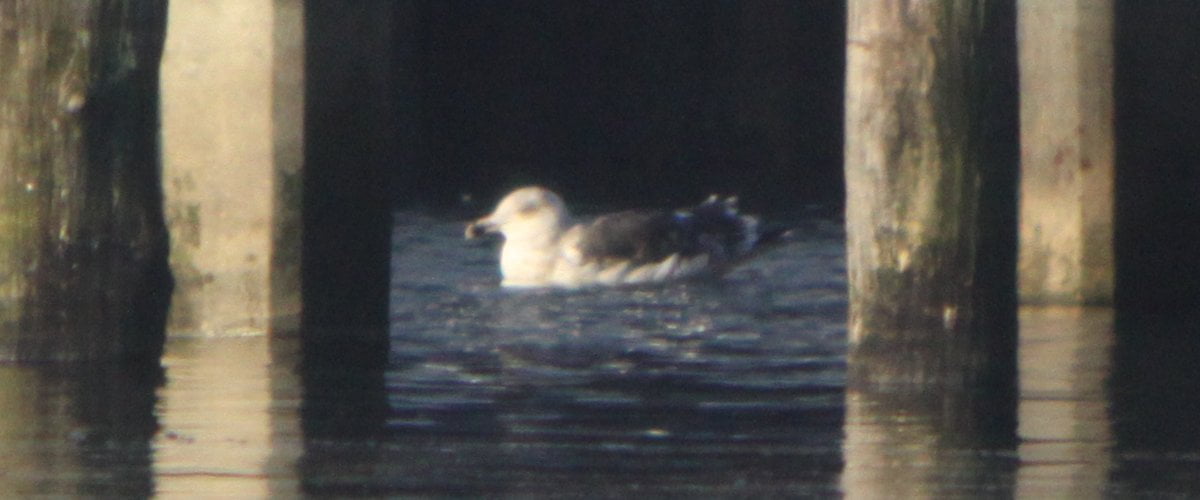










Wow, this must have killed some time for you guys. I am no gull expert but I’ll play the odds and say it’s a GBBG. I’m only saying that so when some expert comes along and confirms it I can say, “I told you so.”
In my opinion this is a Great Black-backed Gull, although I have no field experience with SBGU. Third-cycle SBGU’s have noticeable white “tongue-tips” on at least the sixth and seventh primaries, a feature which is absent on this bird. Also, the amount of white on each primary is much less than expected on a 3rd cycle SBGU at this time of year. I may be mistaken, but I believe the bird is showing a p9 mirror in the sixth photo, a feature which is expected on GBBG. In summary, the lack of tongues on p6 and p7, combined with the small amount of white primary tips and a large p10 (and possibly p9) mirror all point towards a 3rd-cycle GBBG.
Very interesting gull. This is what I got from your pictures:
1. Bird looks to be a 3rd year gull, possibly begining transition to full adult plumage. The amount of brown on the bird, in particular the flight shots point to this.
2. Of the 2 regularly occuring dark backed gulls, the bird more resembles Lesser Black-backed Gull than Greater Black-backed Gull, except for your size description.
3. The heavy streaking would be unsual for a GBBG in any plumage, but again fits well for LBBG.
4. The dark wing tips would hint towards SBG, but the “string of pearls” isn’t very visible as I might expect on a bird of this age.
5. The white stripe along the primaries and white spot on the wing tips look within the range of GBBG.
6. When not in direct sun-light, the legs look flesh colored pink instead of a more reddish pink, another point in GBBG favor.
Over all I think there are a couple of key field marks missing to make this a Slaty-backed Gull. I’m thinking its an oddball Great Black-backed Gull in some sort of wierd transitional plumage.
Hmmmm. I wasn’t there.
Purely judging from the pics, I wonder why that should not be a rather normal GBBG?
Examples that fit your bird quite neatly are here from the Netherlands:
http://www.birdpix.nl/album_page.php?pic_id=8402
http://www.birdpix.nl/album_page.php?pic_id=246548
The head profile does look a bit odd and the legs seem to be a bit on the bright side of GBBG, but apart from that… Smallish size could mean it’s a female.
Cheers!
Okay, I found this bird, a Slaty-backed, that’s quite like yours:
http://www.losbird.org/lbrc/gbbgconoverb.htm
Notice however that the pattern of the primaries differs in that the Slaty-backed does not show a white mirror on p10 (as your bird does) but has a hint of the “string of pearls” on its central primaries.
I tell you, in the field I was trying to ask myself why this wasn’t a slightly abnormal GBBG. I didn’t come around until I saw the photos and I really would have liked to have seen the bird more the second time we were there, but we couldn’t refind it.
But the bird is different from the birds in Jochen’s links for two major reasons.
1) The iris was very very pale, like blinding yellow. This was very apparent from 400-500 meters away with direct comparison to comparable 3rd year GBBG in which the iris color was not readily apparent (for instance, I couldn’t make out palish iris color in the subadult GBBGs unless they were within 75m or so).
2) The terminal band on the tail was mostly complete, as you can see in photo 4. Whether that makes a difference, I don’t know. But that’s how it was.
Do the other birders have clearer shots of the primaries? My feeling is that the exact primary pattern will be the deciding factor…
No Corey’s are the best. Photos here don’t help us much, I suppose: http://www.ontfin.com/Word/great-black-backed-gull/
The eye was much smudgier than any of there, though. And again, yellow iris very apparent.
Okay, get Charlie to skype his borther Nial! Time for the cavalry.
@Nate: I only noticed now that you used the metric system in your comment. Well done, my friend, very well done!! 🙂
@Jochen- I visualize distance better in meters, especially longer ones because I imagine an unfurled running track of about 400m.
So I guess no consensus here? Should we submit to ID-Frontiers to get our spirits totally squashed?
Had a chat with my brother, Nial, who agrees with me that not a Slaty-backed. In fact on these images we both thought it looked better for Lesser BBG. The shape and size looks right, as does the large mirror, and many of this age could have pinkish legs. Presumably you ruled out LBBG – can you recall why?
Interesting thought Charlie. I guess we ruled it out because of the pink legs, but most especially because the guys who were on the bird before us had narrowed it to SB of GBB and we went with it. I remember asking about LBB there at the beginning (before we saw the legs) and one of them said something to the effect that Lessers look slighter and more angular than this bird.
But you’re right, of course, it does look like a just under 3rd cycle LBB, which can have flesh-colored legs (see the second photo here: http://www.carolinanature.com/birds/lbbgull.html which looks a great deal like our bird except for the coverts)
I guess our concern was size, though. It was pretty clearly larger than the Herrings around and the Lessers I’ve seen generally are the same size to slightly smaller than Herrings. But my experience is limited. I see Lessers every time I go to the coast anymore, but that’s infrequent at best.
Hi Nate
Assuming the 1st Year bird in the first image is a GBB, then the size difference seems to me quite notable (particularly the thickness of the neck). The bill looks longer and finer in comparison too. Pale irides would work for LBBG.
It’s still a big bird though. Funnily enough we were both looking at images I took in Miami of what I thought was a heavy, bulky LBBG in a gallery at http://10000birds.com/intermedius-lesser-black-backed-gull-in-miami.htm – we both said that if this thing i the gallery is typical of LBBGs in the US, they’d not be easy from a distance…!
What do you reckon?
Cheers, Charlie. It’s funny how the field marks that stood out to me most in the field, namely the yellow eye in the center of that smudgy face, are practically textbook for LBBG while I was trying to make them out to be Slatyback (Will, further up, also deserves some credit for suggesting LBBG too). Goes to show how wedded one can be to a certain field mark when you’re looking at the bird, in this case the pink legs, that turns out to be inconsequential at best and completely misleading at worst.
So, I could definitely be convinced and am now leaning LBBG (to the extent that it can be comfortably ID’d at all).